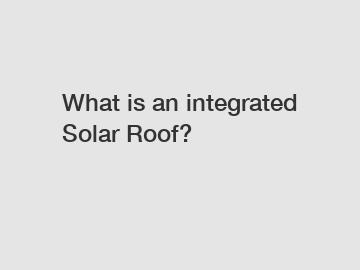What is an integrated Solar Roof?
What is an integrated Solar Roof?
An integrated solar roof refers to a roofing system that incorporates solar panels directly into the structure of the roof, seamlessly blending renewable energy generation with the aesthetic appeal of the building. This innovative technology represents a shift towards more sustainable and efficient energy sources.
The concept of an integrated solar roof originated from the need to maximize the utilization of solar energy and make it more aesthetically pleasing. Traditional solar panels are often mounted separately on rooftops, which can be visually unappealing and detract from the overall design of a building. Integrating solar panels into the roof itself eliminates this issue and allows for a more streamlined and visually appealing appearance.

The process of developing an integrated solar roof involves combining photovoltaic (PV) technology with roofing materials. The PV cells are typically embedded within layers of glass or other transparent materials, which serve as both a protective cover and a means of capturing sunlight. These specially designed roofing materials are engineered to be durable, weather-resistant, and capable of converting solar energy into electricity.
The significance of integrated solar roofs lies in their ability to seamlessly integrate renewable energy generation into our daily lives. By incorporating solar panels into the roof, buildings can harness the power of the sun without compromising on design aesthetics. This integration has the potential to accelerate the adoption of solar energy on a large scale, as it addresses two key concerns: functionality and aesthetics.
From a functional standpoint, integrated solar roofs offer numerous advantages. They provide a sustainable and reliable source of electricity, reducing dependence on traditional fossil fuels and lowering greenhouse gas emissions. In addition, they can generate electricity even in areas with limited space for traditional solar panel installations. This is particularly beneficial for urban areas or buildings with limited rooftop space.
The aesthetic appeal of integrated solar roofs cannot be overstated. By seamlessly integrating solar panels into the roof design, buildings can retain their architectural beauty while embracing clean energy. This helps overcome the perceived trade-off between sustainability and aesthetics, making renewable energy more attractive to consumers and designers alike.
Furthermore, the impact of integrated solar roofs extends beyond individual buildings. As more buildings adopt this technology, the collective solar energy generation can have a substantial impact on reducing carbon emissions and mitigating climate change. By showcasing the feasibility and beauty of integrated solar roofs, this technology has the potential to inspire a widespread shift towards sustainable building practices.
In conclusion, an integrated solar roof represents an innovative and sustainable approach to energy generation. By seamlessly integrating solar panels into the structure of a building's roof, this technology addresses the functional and aesthetic concerns associated with traditional solar panel installations. The widespread adoption of integrated solar roofs can accelerate the transition towards renewable energy sources and contribute to a more sustainable future.
For more bipv curtain walls, oem bipv facade system, solar roof tileinformation, please contact us. We will provide professional answers.

Comments
0